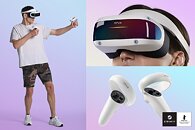TheLostSwede
News Editor
- Joined
- Nov 11, 2004
- Messages
- 18,475 (2.47/day)
- Location
- Sweden
| System Name | Overlord Mk MLI |
|---|---|
| Processor | AMD Ryzen 7 7800X3D |
| Motherboard | Gigabyte X670E Aorus Master |
| Cooling | Noctua NH-D15 SE with offsets |
| Memory | 32GB Team T-Create Expert DDR5 6000 MHz @ CL30-34-34-68 |
| Video Card(s) | Gainward GeForce RTX 4080 Phantom GS |
| Storage | 1TB Solidigm P44 Pro, 2 TB Corsair MP600 Pro, 2TB Kingston KC3000 |
| Display(s) | Acer XV272K LVbmiipruzx 4K@160Hz |
| Case | Fractal Design Torrent Compact |
| Audio Device(s) | Corsair Virtuoso SE |
| Power Supply | be quiet! Pure Power 12 M 850 W |
| Mouse | Logitech G502 Lightspeed |
| Keyboard | Corsair K70 Max |
| Software | Windows 10 Pro |
| Benchmark Scores | https://valid.x86.fr/yfsd9w |
DPVR, a leading provider of virtual reality (VR) devices, has today announced the launch of its newest PC VR gaming headset with the introduction of the 'DPVR E4,' which is aimed at dominating the consumer market for tethered PC VR headsets. In a different category altogether from standalone VR headsets such as the Meta Quest 2 and Pico 4 devices, the DPVR E4 provides PC VR gamers with a tethered alternative that offers a wider field of view (FoV), in a more compact and lighter form factor, as well as offering a more affordable solution compared to high-price tag devices such as the VIVE Pro 2.
DPVR has been making VR headsets for seven years. Prior to E4's launch, the company's efforts were primarily directed towards the B2B market, with a specialized focus on the education and medical industries. Over the last decade, DPVR has completed three successful funding rounds, which the company has used for its research and development efforts into furthering its VR hardware and software offerings. This latest announcement from DPVR marks the company's first step into the consumer VR headset market.

DPVR has been working closely with SteamVR, as it aims to further open up the PC VR gaming market to more users by offering gamers an affordable PC VR headset solution that provides high-resolution images, low latency and precise positioning, all for a more immersive and enjoyable VR gaming experience.
In terms of features, E4 utilizes a HDMI interface, which supports a 120 Hz refresh rate on a SHARP 4K fast LCD screen. The headset also continues to utilize the more cost-effective Fresnel lens, however, the overall device design is more compact than other tethered PC VR headsets on the market, weighing in at just 280 g without head strap. E4 also offers a greater FoV than devices such as the Meta Quest 2.
Finally, the device is equipped with a 16.8 million-color LED light strip on its front shell, allowing gamers to customize the look of their E4 headset to match their existing RGB gaming setups. All of this combined offers gamers a realistic and immersive VR gaming experience at a significantly reduced cost.
DPVR E4 Pricing & Release Date
E4 is available to order starting from Nov 30. DPVR will be showcasing its new VR headset at the VRdays exhibition in Rotterdam this week (Nov 30-Dec 2, Booth 14). The official price of DPVR E4 is $549, with early bird pricing available at $499 for the first 2,000 units purchased between Nov 30-December 31. Devices will begin shipping before Jan 15, 2023. DPVR will also be holding a launch event in China next month, where the full specifications and features of E4 will be announced.
View at TechPowerUp Main Site | Source
DPVR has been making VR headsets for seven years. Prior to E4's launch, the company's efforts were primarily directed towards the B2B market, with a specialized focus on the education and medical industries. Over the last decade, DPVR has completed three successful funding rounds, which the company has used for its research and development efforts into furthering its VR hardware and software offerings. This latest announcement from DPVR marks the company's first step into the consumer VR headset market.

DPVR has been working closely with SteamVR, as it aims to further open up the PC VR gaming market to more users by offering gamers an affordable PC VR headset solution that provides high-resolution images, low latency and precise positioning, all for a more immersive and enjoyable VR gaming experience.
In terms of features, E4 utilizes a HDMI interface, which supports a 120 Hz refresh rate on a SHARP 4K fast LCD screen. The headset also continues to utilize the more cost-effective Fresnel lens, however, the overall device design is more compact than other tethered PC VR headsets on the market, weighing in at just 280 g without head strap. E4 also offers a greater FoV than devices such as the Meta Quest 2.
Finally, the device is equipped with a 16.8 million-color LED light strip on its front shell, allowing gamers to customize the look of their E4 headset to match their existing RGB gaming setups. All of this combined offers gamers a realistic and immersive VR gaming experience at a significantly reduced cost.
DPVR E4 Pricing & Release Date
E4 is available to order starting from Nov 30. DPVR will be showcasing its new VR headset at the VRdays exhibition in Rotterdam this week (Nov 30-Dec 2, Booth 14). The official price of DPVR E4 is $549, with early bird pricing available at $499 for the first 2,000 units purchased between Nov 30-December 31. Devices will begin shipping before Jan 15, 2023. DPVR will also be holding a launch event in China next month, where the full specifications and features of E4 will be announced.
View at TechPowerUp Main Site | Source






